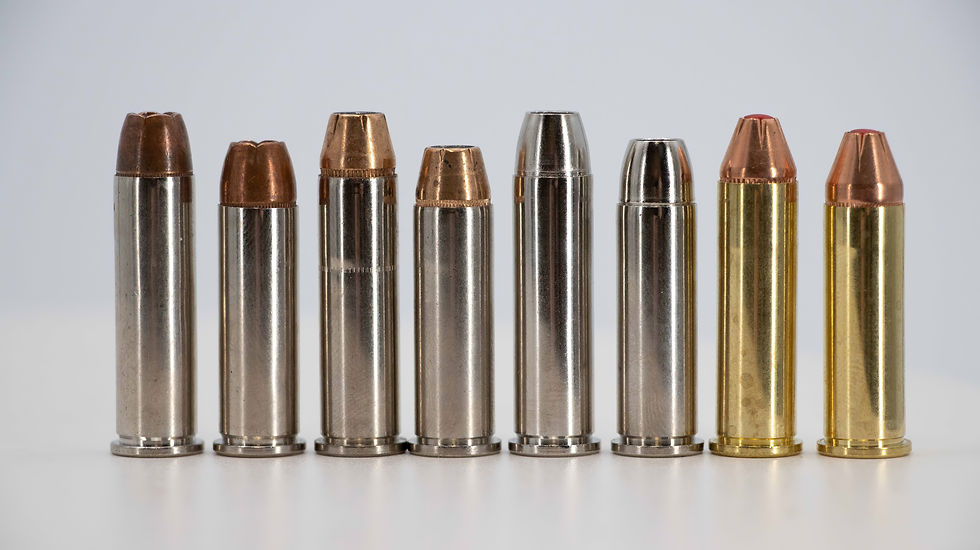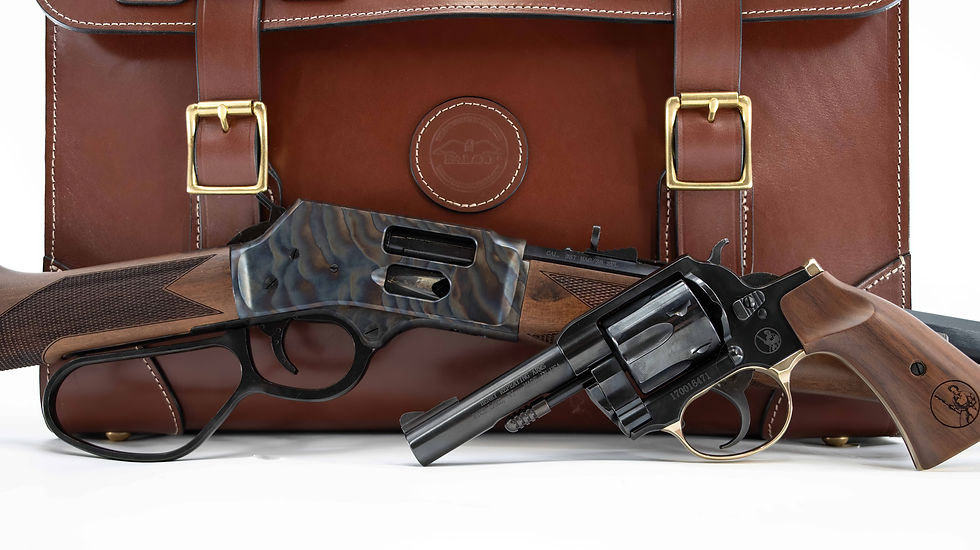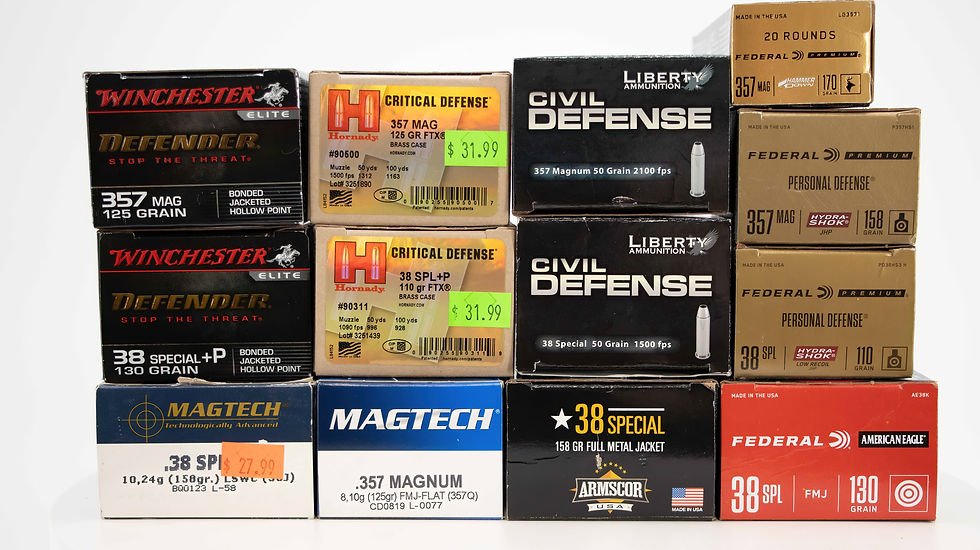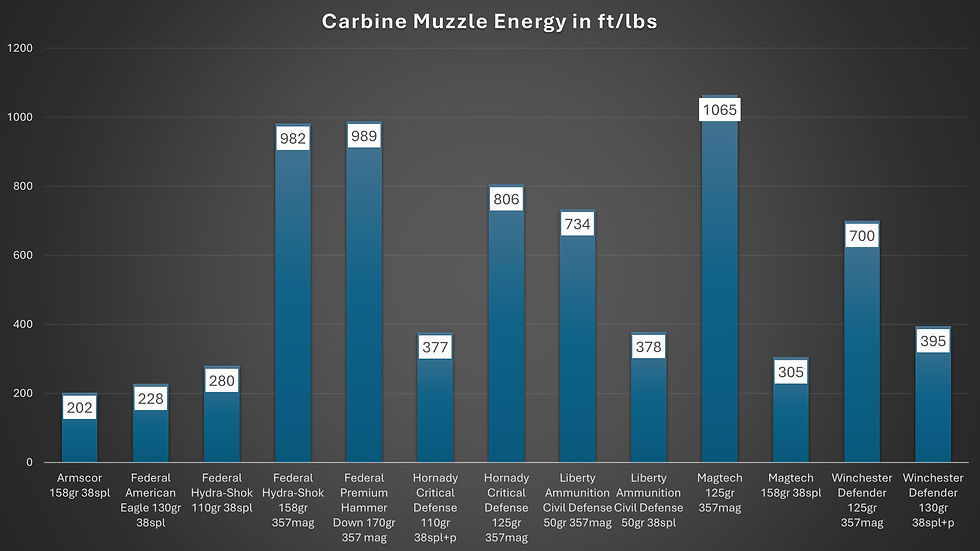.38 Special, .357 Magnum, and Why You Should Care to Know
- Graham Baates

- 15 hours ago
- 7 min read
*Some of the external links found on this website are affiliate links. Those links use cookies to generate revenue and fund continuation of this website. By clicking an external link you are consenting to a temporary cookie, by purchasing from that link you are supporting this website. To opt out of cookies do not click external links.

These two calibers have been around a while, and somewhat fallen out of mainstream thanks to 9mm semi-automatic handguns, but the two combined offer quite a wide range of potential. This post was mad epossible thanks to Henry Repeating Arms Company who sent out a Big Boy carbine and Big Boy revolver to help us all learn something.

The Basics
.38 Special, known as 9x29mmR in some parts of the world, has been around since 1898 and was originally a black powder cartridge. It has served in wars ever since and was a common police caliber in the United States from the 1920s until the 1990s. SAAMI has set a maximum pressure of 17,500psi (20,000psi for +p loads) and a test barrel of 7.71" (a size unlikely to be found today). In my tests are loads ranging from 50gr to 158gr. .38 Special can be fired in most firearms chambered for .357 Magnum as it has a lower pressure, but the shorter case length and overall loaded length may cause issues in some lever guns.
.357 Magnum, known as 9x33mR in some parts of the world came about in 1935. Legend is creation was needed because cover behind automobiles and bullet proof vests at the time used by some bootleggers could stop a .38 Special. SAAMI has set a maximum pressure of 35,000psi (formerly 43,000psi) and no specific test barrel length. Loads in my tests ranged from 50gr to 170gr. .357 Magnum should not be used in a firearm labeled ".38 Special" as it has a significantly higher pressure. The case length and overall loaded length are longer which should prevent use in something chambered for .38 Special only.

The Difference in Plain Speak
Energy! In my tests the 4" Henry Big Boy Revolver made between 197ft/lbs and 529ft/lbs, the Henry Big Boy Carbine between 202ft/lbs and 1,065ft/lbs depending on the load! Muzzle energy isn't everything, but it does give us an idea of how hard the bullet will hit the target and what kind of recoil one can expect. In the revolver the strongest load was 2.69x more powerful than the weakest, in the carbine the strongest was 5.27x more powerful than the weakest. For reference, your standard 4" 9mm pistol with 115gr ammunition produces something in the low-to-mid 300ft/lbs range.
It's generally assumed that a longer barrel and sealed action like the Henry Big Boy Carbine will provide more velocity, and therefore energy, than a 4" revolver with a cylinder gap like the Henry Big Boy Revolver, but that depends on the load. How much powder, powder burn rate, and friction between projectile and bore are all factors.

Why Bother?
I wanted to learn what the practical differences were between the calibers, and what difference a 16" barrel would make over a 4". In the past we've discovered increadible feats of 9mm in the Liberty Ammunition test, and also been somewhat disappointed by longer barrels with 10mm. Because intended optimal performance can vary from manufacturer to manufacturer and load to load, four pairs of loads were purchased in addition to nine randomly selected loads. Let's find out what you get when you just pick up a box of the caliber you're looking for without knowing what that load can do, and run it in both your revolver and carbine.
Test Parameters
5 rounds chronographed from 7yards, velocity averaged and computed with bullet weight to find muzzle energy.
Test elevation: approximately 300'
Test Air temperature: 52f
All ammunition was purchased within one month of testing, kept in a climate-controled environment until tested.
Testing terminal effectiveness proves morally and legally challenging. This is a test of muzzle energy and difference between carbine and revolver.

Loads Tested:
50gr .38spl Liberty Ammunition Civil Defense $40.33 / 20 from Global Ordnance
50gr .357mag Liberty Ammunition Civil Defense $41.55 / 20 from Global Ordnance
110gr .38spl Federal Hydra-Shok $35.99 / 20 direct from Federal
110gr .38spl+p Hornady Critical Defense $30.34 / 25 from Global Ordnance
125gr .357mag Winchester Defender $34.12 / 20 from Global Ordnance
125gr .357mag Hornady Critical Defense $31.56 / 25 from Global Ordnance
125gr .357mag Magtech FMJ $32.28 / 50 at from Global Ordnance
130gr .38spl Federal American Eagle $38.99 / 50 direct from Federal
130gr .38spl+p Winchester Defender $29.47 / 20 at Global Ordnance
158gr .38spl Armscor $24.56 / 50 at Global Ordnance
158gr .357mag Federal Hydra-Shok $39.99 / 20 direct from Federal
170gr .357mag Fderal Hammer Down $27.92 / 20 from Global Ordnance
The Pairings
We didn't see anything too shocking or impressive when looking at the selected pairings. You can watch each test video to get a concept of recoil, but by loking at the numbers I think .357 Magnum is the way to go with a carbine as the .38 Special loads didn't always make a gain worth carying a largert firearm.


Federal Hydra-Shok proved to have a substantial difference between the two calibers, and the .357 Magnum really took off when put in the 16" barrel. The .38 Special must have already been tired, yielding less energy from a carbine than even a short 9mm pistol. If you're looking to pair a revolver and carbine with the same ammunition, and use that carbine when you want definitively more power, the .357 Magnum load is a clear choice.
110gr .38spl Federal Hydra-Shok $35.99 / 20 direct from Federal
158gr .357mag Federal Hydra-Shok $39.99 / 20 direct from Federal


Hornady Critical Defense showed .38 Special+p can take better advantage of a longer barrel, though the .357 Magnum load didn't gain as much as Federal's. In both cases however the .357 Magnum load acheived roughly double that of the .38 Special+p load. The difference between those two was something I was personally curious about.
110gr .38spl+p Hornady Critical Defense $30.34 / 25 from Global Ordnance
125gr .357mag Hornady Critical Defense $31.56 / 25 from Global Ordnance


Liberty Ammunition's Civil Defense load is a personal favorite of mine in 9mm; generating massive energy and practically exploding inside soft targets. While the results here weren't the "wow" I was expecting, we do know that with Liberty Ammunition Civil Defense all energy WILL be dumped in a soft target. Recoil was also noticable lighter than other loads producing similar energy.
50gr .38spl Liberty Ammunition Civil Defense $40.33 / 20 from Global Ordnance
50gr .357mag Liberty Ammunition Civil Defense $41.55 / 20 from Global Ordnance


Winchester Defender surprised me. I've known Winchester to typically load hot, especially in their 9mm offerings. That must be where they pour the powder meant for .38 Special+p because that load was pitiful. Again, we don't know what terminal performance is like, but the energy created was not impressive. The .357 Magnum load performed about like the rest. Both cartridges benefited from the carbine barrel, but again the .38 Special load barely matched a 9mm from a 4.25" barrel.
130gr .38spl+p Winchester Defender $29.47 / 20 at Global Ordnance
125gr .357mag Winchester Defender $34.12 / 20 from Global Ordnance

Carbine Vs Revolver

The companion concept made sense in the 19th century and makes sense today. As a guy with dozens of calibers of firearms I concretely appreciate the idea of having one caliber serve multiple purposes, or at least serve in multiple firearms. As a reviewer it hits even harder (ever stop to think what these tests cost to setup?). Modern plinkers may want to have a pairing that performs similarly in both rifle and revolver while hunters and back country explorers may want to find a load that makes it worth bringing a rifle and revolver along. The good news is this test shows there are ammunition choices for both. The above chart shows the gain in muzzle ernergy in a carbine over a revolver, but that doesn't tell the whole story.

The above chart shows us Armscor's .38 Special load was likely not intended for carbines, and MagTech's 125gr .357 Magnum effectively add's two 9mm shot's worth of energy when you put it in a carbine. Federal's .357 Magnum loads also had substantial gains in both loadings. If you're just looking to plink without much difference between the two Federal American Eagle 130gr .38 Special and for a familiar feel with terminal enhancement Federal Hydra-Shok 110gr .38 Special is the way to go.











Comments